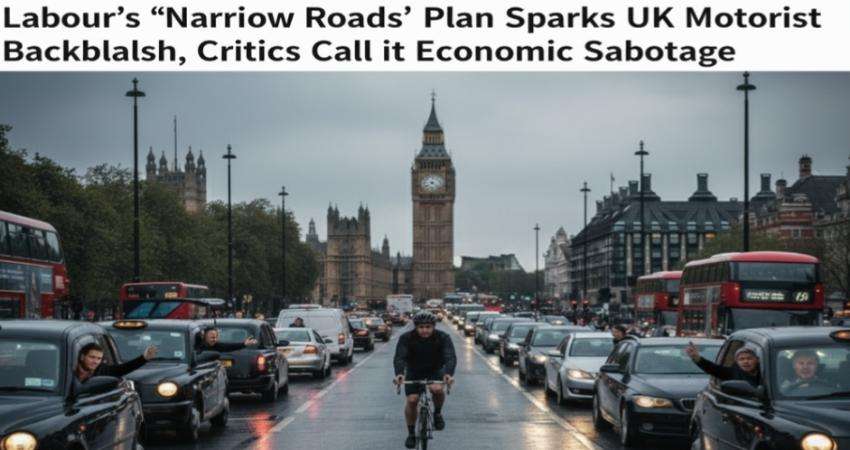IA controversial proposal from a Government agency, potentially set to be embraced by a future Labour administration, threatens to drastically reshape the UK’s road network, drawing immediate and fierce opposition from motoring groups. The guidance, issued by Active Travel England (ATE), recommends that highways authorities avoid new road lane widths between 3.25 m and 3.9m. The explicitly stated aim is to narrow lanes—which have typically been built at 3.6 mfor over a century—to a point where drivers simply cannot overtake cyclists safely, forcing them to wait, Daily Dazzling Dawn realized.
Congestion Fears and the London Problem-The plan is facing heavy criticism for its complete disregard for the practical realities of the British road system, particularly in major cities. London, in particular, is frequently cited as having some of the narrowest, most historically constrained roads in the world, a legacy of medieval and Roman planning. Implementing such a strategy on London's thoroughfares, which are already choked with traffic, buses, emergency services, and delivery vans, would, critics argue, be catastrophic. It is widely predicted that the mandatory slowing of all traffic to the speed of a bicycle would create unprecedented gridlock, turning minor delays into hours of lost time for commuters and businesses. This is despite the ATE guidance suggesting that lanes under 3.25m are safer as they clearly discourage unsafe overtaking, a measure already being trialled in parts of the City of London.
The Economic Cost of Gridlock-Motoring organisations are condemning the move as an ill-conceived "war on motorists" that will inflict serious economic damage. Brian Gregory, policy director at the Alliance of British Drivers, labelled the new guidance as "completely stupid," arguing that deliberately slowing all motor traffic to the speed of a bicycle on narrow roads represents a "huge economic cost to the country in wasted time." This wasted time translates directly into reduced productivity, higher operational costs for logistics and transport, and increased prices for consumers. Independent studies on congestion have already shown that traffic gridlock could cost the UK economy hundreds of billions of pounds by 2030, a figure this policy is widely expected to exacerbate, not alleviate. The plan is seen not as a safety measure born of cooperation but as a punitive action aimed solely at making driving unpleasant.
Impracticality on Ancient Roads-Another major point of criticism centres on the sheer impossibility of fundamentally redesigning the UK's ancient road infrastructure. Edmund King, president of the AA, was quick to point out the crucial difference between the UK and countries like the US, stating that it is "impossible and impractical to change the widths of all our roads, which have evolved since Roman times." Unlike countries with relatively new, wider highways, Britain’s historical roads inherently require a degree of "give and take" between different road users—a necessary compromise that cannot simply be regulated out by mandates on lane width. The ATE’s focus on the narrow overtaking space is also critiqued as ignoring the fact that lane widths between the specified 3.25mand 3.9m already cause issues where there are unavoidable obstructions, like pedestrian islands, where overtaking is already perilous. Furthermore, the ATE guidance itself admits that lanes wider than 3.9m may still not allow a driver to comply with the 1.5m safe passing distance required by the Highway Code when a cyclist is close to the kerb.
Labour's Denial vs. Government Action-While Transport Secretary Heidi Alexander has denied any "war on motorists," the release of the ATE guidance is viewed by many as evidence to the contrary, or at least a significant step toward making driving more difficult under the guise of 'active travel'. Furthermore, critics point out the disparity between proposed new anti-car measures and the current government’s investment pledges. A Department for Transport spokesman has sought to reassure drivers, stating the claims misrepresent the guidance and that there has never been legally binding standards for road widths. They highlighted recent investment, including an extra 500m for pothole repair and 1bn for bridge maintenance, attempting to show that the government is, in fact, "on the side of drivers." However, opponents argue that such maintenance spending does not mitigate the profound long-term impact of intentionally constricting the flow of traffic across the entire national network, maintaining that the core of the ATE recommendation is an anti-motorist policy designed to deter driving rather than to foster a safe and cooperative environment for all road users.




.jpg)



.svg)



.jpg)